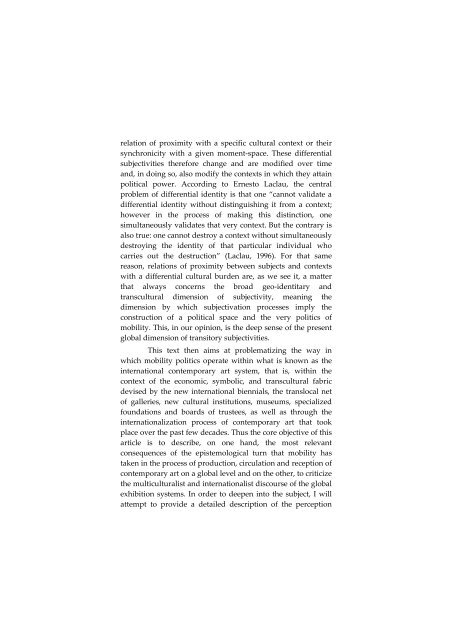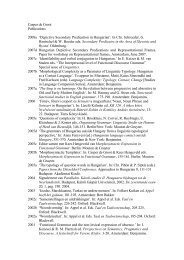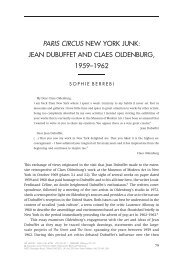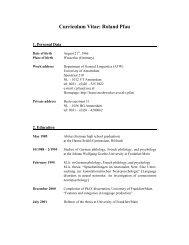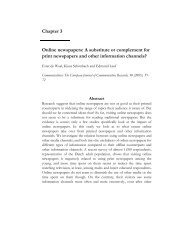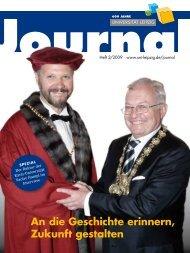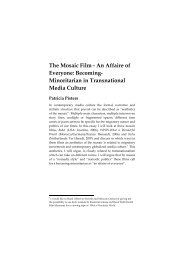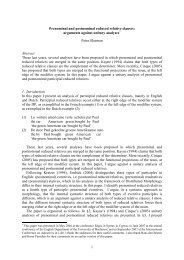Global Art And Politics Of Mobility: (Trans)Cultural Shifts in the ...
Global Art And Politics Of Mobility: (Trans)Cultural Shifts in the ...
Global Art And Politics Of Mobility: (Trans)Cultural Shifts in the ...
You also want an ePaper? Increase the reach of your titles
YUMPU automatically turns print PDFs into web optimized ePapers that Google loves.
elation of proximity with a specific cultural context or <strong>the</strong>ir<br />
synchronicity with a given moment-space. These differential<br />
subjectivities <strong>the</strong>refore change and are modified over time<br />
and, <strong>in</strong> do<strong>in</strong>g so, also modify <strong>the</strong> contexts <strong>in</strong> which <strong>the</strong>y atta<strong>in</strong><br />
political power. Accord<strong>in</strong>g to Ernesto Laclau, <strong>the</strong> central<br />
problem of differential identity is that one “cannot validate a<br />
differential identity without dist<strong>in</strong>guish<strong>in</strong>g it from a context;<br />
however <strong>in</strong> <strong>the</strong> process of mak<strong>in</strong>g this dist<strong>in</strong>ction, one<br />
simultaneously validates that very context. But <strong>the</strong> contrary is<br />
also true: one cannot destroy a context without simultaneously<br />
destroy<strong>in</strong>g <strong>the</strong> identity of that particular <strong>in</strong>dividual who<br />
carries out <strong>the</strong> destruction” (Laclau, 1996). For that same<br />
reason, relations of proximity between subjects and contexts<br />
with a differential cultural burden are, as we see it, a matter<br />
that always concerns <strong>the</strong> broad geo-identitary and<br />
transcultural dimension of subjectivity, mean<strong>in</strong>g <strong>the</strong><br />
dimension by which subjectivation processes imply <strong>the</strong><br />
construction of a political space and <strong>the</strong> very politics of<br />
mobility. This, <strong>in</strong> our op<strong>in</strong>ion, is <strong>the</strong> deep sense of <strong>the</strong> present<br />
global dimension of transitory subjectivities.<br />
This text <strong>the</strong>n aims at problematiz<strong>in</strong>g <strong>the</strong> way <strong>in</strong><br />
which mobility politics operate with<strong>in</strong> what is known as <strong>the</strong><br />
<strong>in</strong>ternational contemporary art system, that is, with<strong>in</strong> <strong>the</strong><br />
context of <strong>the</strong> economic, symbolic, and transcultural fabric<br />
devised by <strong>the</strong> new <strong>in</strong>ternational biennials, <strong>the</strong> translocal net<br />
of galleries, new cultural <strong>in</strong>stitutions, museums, specialized<br />
foundations and boards of trustees, as well as through <strong>the</strong><br />
<strong>in</strong>ternationalization process of contemporary art that took<br />
place over <strong>the</strong> past few decades. Thus <strong>the</strong> core objective of this<br />
article is to describe, on one hand, <strong>the</strong> most relevant<br />
consequences of <strong>the</strong> epistemological turn that mobility has<br />
taken <strong>in</strong> <strong>the</strong> process of production, circulation and reception of<br />
contemporary art on a global level and on <strong>the</strong> o<strong>the</strong>r, to criticize<br />
<strong>the</strong> multiculturalist and <strong>in</strong>ternationalist discourse of <strong>the</strong> global<br />
exhibition systems. In order to deepen <strong>in</strong>to <strong>the</strong> subject, I will<br />
attempt to provide a detailed description of <strong>the</strong> perception


